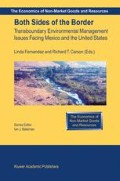Abstract
The Mexico-US border highlights population and economic growth in an “artificial” desert environment—there would not be 12 million residents along the 2000 mile border if it were not an international border. For most of the 20th century, there were only three major population centers along the border: the lower Rio Grande Valley, the El Paso-Juarez area, and the San Diego-Tijuana area. There were one million residents along the border in 1942, but then the border-area population became to grow, especially on the Mexican side, during the 1942–64 Bracero program, under which Mexicans could work legally on US farms. The border area population grew even faster after the maquiladora or foreign-owned assembly plant industry expanded in the wake of peso devaluations in the 1980s and 1990s.
In 2000, there were 6.5 million people in the counties along the US side of the border, and 5.8 million on the Mexican side—the total border area population rose 50 percent in the 1990s, from 8 to 12 million, and is projected to double to 24 million by 2020. The border area’s major economic engine is manufacturing and related services—some 1.4 million Mexicans are employed in 3,500 border-area maquiladoras, and the presence of these assembly plants explains much of the population growth on both sides of the border in the past two decades. The North American Free Trade Agreement (NAFTA) was expected to divert the industrialization of Mexico away from the border, but has so far not had this effect.
The Mexico-US border area in the 21st century is at a crossroads. Irrigated agriculture is shrinking on the US side, and not growing significantly on the Mexican side—scarce water is likely to be diverted from irrigating crops to higher value urban uses. Wages are lower but unemployment and poverty rates on the US side of the border are typically 2–3 times higher than the US average (San Diego county is the exception). By contrast, the Mexican side of the border is marked by higher-than-average wages and lower-than-average unemployment: maquiladoras constantly advertise for workers, population growth outstrips infrastructure development, and traffic to move goods, migrants, and shoppers across the border leads to significant waits at border crossings. Thus, the people picture of the border is one in which Mexicans migrate from poorer inland areas to what is for Mexico and relatively rich area, and the American residents along the border are largely Mexican-Americans with relatively little education and skills (San Diego is the exception).
Access this chapter
Tax calculation will be finalised at checkout
Purchases are for personal use only
Preview
Unable to display preview. Download preview PDF.
Bibliography
Binational Study on Migration. 1997. US Commission on Immigration Reform. Washington: US Commission on Immigration Reform. September. (http://www.migration.ucdavis.edu/mn/cir_mn.html)
Cornelius, Wayne and David Myhre. 1996. The Transformation of Rural Mexico: Reforming the Ejido Sector. La Jolla: Center for US-Mexican Studies
de Janvry, Alain, Elisabeth Sadoulet, and Gustavo Anda. 1994. NAFTA and Mexico’s Corn Producers. Berkeley: UC ARE Working Paper 275. July.
Huerta, Mario M. Carillo. 1990. The Impact of Maquiladoras on Migration in Mexico, Working Paper 51 of the U.S. Commission for the Study of International Migration and Cooperative Economic Development, July.
Hufbauer, Gary and Jeffrey Schott. 1992. North American Free Trade: Issues and Recommendations. Washington: Institute for International Economics.
Lustig, Nora. 1992. Mexico: The Remaking of an Economy. Washington, Brookings Institution.
Martin, Philip. 1993. Trade and Migration: NAFTA and Agriculture. Washington: Institute for International Economics
Martin, Philip. 1996. Promises to Keep: Collective Bargaining in California Agriculture. Ames, IA: Iowa State University Press.
Massey, Douglas S. 1998. March of Folly: U.S. Immigration Policy After NAFTA. The American Prospect no. 37 March—April. 22—33. (http://www.epn.org/prospect/37/37massnf.html)
Massey, Douglas, Rafael Alarcon, Jorge Durand, and Humberto Gonzales. 1987. Return to Aztlan: The Social Process of International Migration from Western Mexico. Berkeley, CA: University of California Press.
Massey, Douglas S. 1988. Economic Development and International Migration in Comparative Perspective. Population and Development Review, Vol. 14, No. 3 September. 383–413.
Migration News. Monthly since 1994 (http://www.migration.ucdavis.edu)
Rural Migration News. Quarterly since 1995 (http://www.migration.ucdavis.edu)
Seligson, Mitchell and Edward Williams. 1981. Maquiladoras and Migration: A Study of Workers in the Mexican-United States Border Industrialization Program. Austin: University of Texas.
Thompson, Gary and Philip Martin. 1989. The Potential Effects of Labor Intensive Agriculture in Mexico on U.S.-Mexico Migration, Working Paper 11 of the U.S. Commission for the Study of International Migration and Cooperative Economic Development.
U.S. Commission for the Study of International Migration and Cooperative Economic Development. 1990. Unauthorized Migration: An Economic Development Response.
Weintraub, Sidney. 1990. A Marriage of Convenience: Relations between Mexico and the United States. New York: Oxford University Press.
Zabin, Carol, et. al. 1993. Mixtec Migrants in California Agriculture: A New Cycle of Rural Poverty.. Davis: California Institute for Rural Studies.
Author information
Authors and Affiliations
Editor information
Editors and Affiliations
Rights and permissions
Copyright information
© 2003 Kluwer Academic Publishers
About this chapter
Cite this chapter
Martin, P. (2003). Immigration, Agriculture, and the Border. In: Batema, J.J., Fernandez, L., Carson, R.T. (eds) Both Sides of the Border. The Economics of Non-Market Goods and Resources, vol 2. Springer, Dordrecht. https://doi.org/10.1007/0-306-47961-3_7
Download citation
DOI: https://doi.org/10.1007/0-306-47961-3_7
Publisher Name: Springer, Dordrecht
Print ISBN: 978-1-4020-7126-3
Online ISBN: 978-0-306-47961-8
eBook Packages: Springer Book Archive

